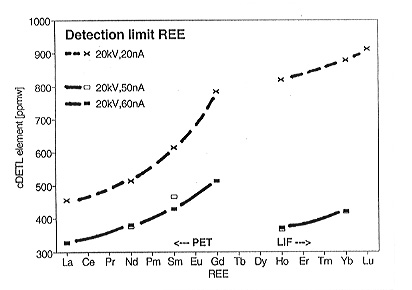

Knowledge of the partitioning of rare earth elements (REE, 57La to 71Lu) between upper mantle minerals is essential toward the understanding of geochemical processes. Experiments were performed in the system CaO-MgO-Al2O3-SiO2 with the phases olivine, orthopyroxene, clinopyroxene, and garnet at high concentrations of selected REE (La, Nd, Sm, Gd, Ho, Yb). In the experiments only one REE was added to avoid line overlaps in electron microprobe analyses. The aims of this part of the study are to investigate the suitability of electron probe microanalysis for this project, and to determine maximum solubilities of REE in these phases.
The possibilities and limitations of electron probe microanalysis need
to be known prior to the analysis of runs with REE added in trace amounts.
For statistical confidence, a minimum number of 10 points on one mineral
grain was considered necessary, and several grains of the same phase required
analysis in each sample. Therefore, a total counting time of 5 minutes
was not exceeded. A test of different analytical conditions (20 kV and
20 nA, 50 nA, 60 nA) and counting times showed that for REEPO4
standards a detection limit of ca. 350 ppm (wt) was determined (Fig. 3.8-4).
Therefore, ion-probe microanalysis is considered to be a more suitable
method at lower REE concentrations. In such cases, secondary standards
are synthesized for ion probe analysis.
 |
|
|
Determining the maximum concentration of REE in the phases is also required, before reversal experiments can be performed. For these experiments only one of the phases is doped with a REE at high concentrations. The maximum concentrations in clinopyroxene and garnet allow starting concentrations up to several wt% of REE. For the reversal experiments the concentration of the doped phase is chosen according to the results of synthesis experiments at low concentration.
The use of a flux was found to be necessary, because in synthesis experiments starting from the oxides at 1400°C and 1200°C at 3 GPa equilibrium was not reached as indicated by the presence of different REE contents in adjacent grains of one phase. For example, in Ho-doped systems the garnets consist of a multiple-core and a symplectite-like growth rim of two garnets with different compositions, containing 11.5 or 15.5 wt% Ho, respectively. This observation is suggestive of diffusion-controlled growth in a refractory system and shows that even at 1400°C homogenization within a 1 day run duration is not achieved. In runs with La or Nd added it is not possible to analyze the concentrations of these elements in olivine and orthopyroxene using the selected analytical conditions of the electron microprobe because the concentrations in these phases fall below the detection limit. For Nd in an amphibole a similar situation has been reported in the literature.

Tel: +49-(0) 921 55 3700 / 3766, Fax: +49-(0) 921 55 3769, E-mail: bayerisches.geoinstitut(at)uni-bayreuth.de
 Previous page
Previous page